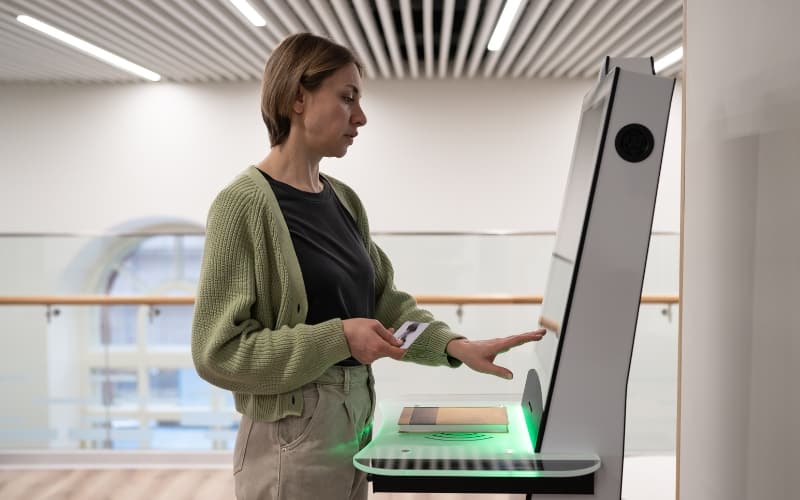For Lee, efficiency is more than a buzzword. It’s the result of designing services so people can help themselves without unnecessary delays or confusion. That means creating clear information, timely reminders, and intuitive tools that remove barriers between residents and the services they need.
From one-way to two-way engagement
Speaking to an audience of public sector innovators, Lee described a major shift underway: Moving from one-way to two-way communication and from one-to-many to one-to-one interactions.
By combining personalized communication with data insights and modern identity tools — like single sign-on — agencies can tailor their outreach to individual needs. This makes it possible to send targeted, timely messages that drive action, whether it’s renewing a permit, attending a hearing, or updating vital information.
“When you can reach someone directly and say, ‘You’re about to miss a deadline’ or ‘Your benefits are ready to process,’ you’re not just delivering a service. You’re creating trust.”
Charlotte Lee
Strategic Growth Director at Granicus
She also stressed that decision-making improves when data and identity come together. Leaders can better determine where to invest, how to allocate resources, and how residents are responding to programs in real time.
Modernization in Maryland: From projects to products
This focus on outcomes over outputs resonated with Jenny Smith, senior director of strategic investments at the Maryland Digital Service. Smith’s team manages the state’s IT investment fund and sets standards for major IT projects, giving them both the authority and the responsibility to steer modernization efforts.
“We’re trying to pivot from a very project-centric approach to technology to a product-centric approach,” Smith explained. “Technology implementation is really about solving problems for users and for programs, not just about implementing systems.”
Smith shared a recent win: Modernizing the Veterans Trust Fund application, which provides one-time financial support to veterans in crisis. The old process was cumbersome and slow. By working closely with the Department of Veterans and Military Families, her team streamlined both the application and the back-end approvals.
“In the first week after launch, we helped two veterans save their homes from foreclosure,” Smith said. “That’s the kind of impact that shows why this work matters.”
Baltimore’s data-driven transparency
For Webster Mulbar, chief data officer at the Baltimore City Department of Transportation, innovation is about giving residents clear, accessible information on projects that affect their daily lives.
“We hyper-focus on utility,” Mulbar said. “We want to make sure the products we’re building provide visibility into the work we’re doing — from when a traffic calming project is scoped to when the pavement is laid.”
Mulbar’s team is designing tools that let residents track timelines, understand project scope, and see progress in their neighborhoods. The goal is to build trust through transparency and create feedback loops that improve future projects.
Loudoun County: Strategic partnerships and speed
In Loudoun County, Virginia, Director of IT Nate Wentland is focused on speed, agility, and partnerships.
“Don’t just replace a system the way you built it 10 years ago,” Wentland advised. “Look at where you want to be in five years, then find partners that can help you get there.”
Wentland shared how Loudoun’s adoption of an analytics platform has transformed operations. In one case, the Sheriff’s Department used data from video feeds and multiple sources to locate a murder suspect within hours, intercepting him at the airport before he could leave the state.
“We’re using data not just to analyze, but to take action quickly,” Wentland said. “That’s a game-changer for public safety and for residents.”
The human side of change
Across all three jurisdictions, change management emerged as a critical factor. Smith noted building trust with agencies is key: “If we’ve done the work upfront to build relationships, agencies are much more open to collaboration and to aligning on shared goals.”
Mulbar emphasized listening: “We survey residents after projects are complete to measure what went well and what didn’t — and then we follow up. Residents need to know their feedback leads to action.”
Wentland agreed, adding, “All the departments are my customers, and the residents are theirs. Listening and partnering is the only way to move forward.”
A vision to rally around
Lee closed her remarks with advice for leaders: Anchor transformation in a shared vision. Whether it’s reducing DMV wait times to 15 minutes or creating a “Disney-like” experience for permit applications, a clear, compelling goal helps align teams, vendors, and stakeholders.
“Transformation is expensive, risky, and scary, but when you have a vision everyone can rally around, you can turn that fear into momentum.”
Charlotte Lee
Strategic Growth Director at Granicus
Lasting impact
The Route50 Digital Service Delivery Innovation Showcase made one thing clear: Technology alone isn’t the answer. Fundamental transformation happens when agencies align strategy, design, and tools to meet human needs, continuously improving along the way.
As Lee put it, “There’s no end state. Success is forever making sure we’re meeting user needs.”
Interested in learning more? Watch the recording.







